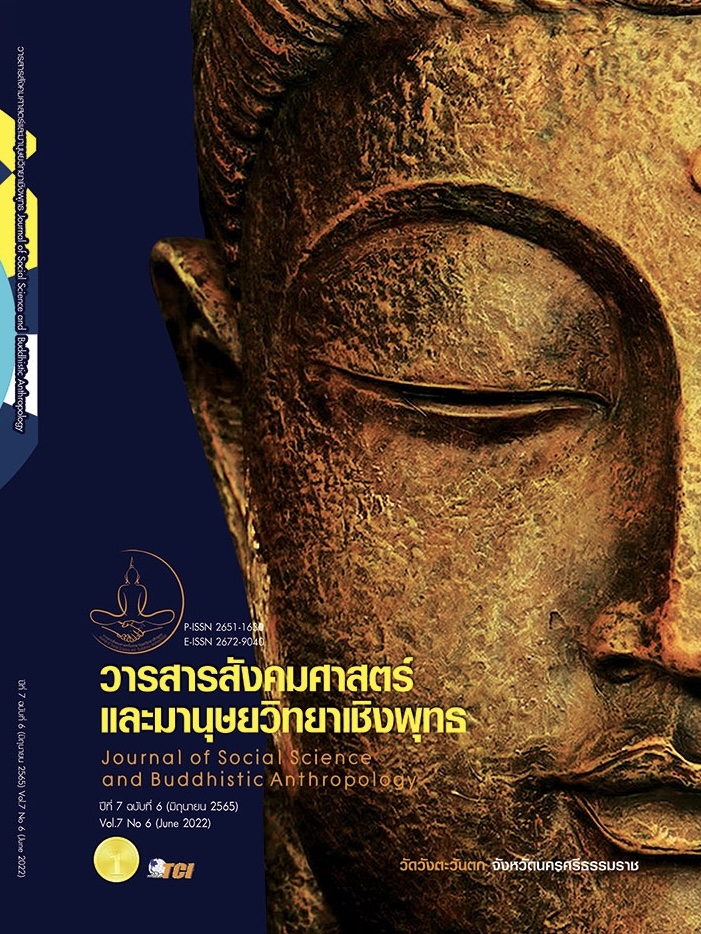WHEEL FOR LOCOMOTIVE WELLNESS: INTERPRETATION OF CULTURE DIMENTIONS
Keywords:
Culture, Ethnic, Wheel, Locomotive WellnessAbstract
The objectives of this research article were to studying wheel culture for locomotive wellness in relation to cultural and religious interpretations in Thailand. This ethnographic research uses qualitative research method to study related documents, in-depth interviews, and participant observations (2016-2018 A.D.) 17 key informants are representatives from ethnic groups in various locations which consist of 10 from Thailand, 3 from Vietnam, 2 from India, 1 from Lao PDR and 1 from Cambodia. The data are analyzed in terms of the content and later on summarized. The results show that in terms of culture, the wheel technology is designed and invented in accordance with the culture of the community in each area. It received the impact from the rice culture in the way that it is rice farming society which is part of the social economic culture, including agriculture, trade, handicrafts, and industry. Wheel carts and bicycles are vehicles that require human and animal power to drive the wheels. This is caused by culture and wisdom that uses physical and mental powers to prevent disease. The wheel is therefore a symbol used to describe the mechanism of life that affects the promotion of locomotive wellness. The wheel culture is related to Buddhist teaching that persuades people to change their way of life to use clean energy. The rotation of the wheel is therefore like a wheel of Dharma in dissemination and symbolism in Buddhism. The wheel of the Trimurti which is the creator, the preserver, and destroyer, means that being born, being old, being ill and being dead are the mechanism of all lives. The rotating of the wheel leads to learning Pratityasamutpada where a wheel with 14 spokes represents “Kong 14” or the 14 traditions and the 16 spokes represent the Noble Eightfold Path.
References
กรมศิลปากร กระทรวงวัฒนธรรม. (2552). รถม้าและพาหนะร่วมสมัย. กรุงเทพมหานคร: รุ่งศิลป์การพิมพ์.
คมกฤช อุ่ยเต็กเค่ง. (13 กันยายน 2560). วงล้อในความหมายทางศาสนาฮินดู. (นางสาวเจนการ ชูเชิด, ผู้สัมภาษณ์)
จักระ. (2559). จักระ. เรียกใช้เมื่อ 13 มีนาคม 2559 จาก https://th.wikipedia.org/wiki/จักระ
จัสมิน ดูเบย์. (22 ตุลาคม 2560). วงล้อในศาสนาฮินดูและพุทธ. (นางสาวเจนการ ชูเชิด, ผู้สัมภาษณ์)
เจริญ ไวรวัจนกุล. (2549). จากอารยธรรมสุเมเรียลุ่มน้ำไทกริส สู่อารยธรรมลุ่มน้ำโขง. สุรินทร์: มหาวิทยาลัยราชภัฏสุรินทร์.
เจ้าอาวาสวัดชัวมุยไน. (28 กรกฎาคม 2561). คนเวียดนามให้ความสำคัญกับการใช้วงล้อในด้านใด. (นางสาวเจนการ ชูเชิด, ผู้สัมภาษณ์)
ชนม์บันลือ วรรธนพันธ์. (24 กันยายน 2559). สิ่งที่ได้จากการเรียนรู้ในการใช้จักรยาน. (นางสาวเจนการ ชูเชิด, ผู้สัมภาษณ์)
ชานนท์ หนุนชู. (14 สิงหาคม 2559). สุขภาพกับการออกกำลังกาย. (นางสาวเจนการ ชูเชิด, ผู้สัมภาษณ์)
เชียงเงิน บุญปลูก. (11 สิงหาคม 2559). การฝึกฝนดูแลสัตว์ที่นำมาใช้งาน. (นางสาวเจนการ ชูเชิด, ผู้สัมภาษณ์)
ณัฏฐภัทร์ จันทวิช. (2541). ธรรมจักรในประเทศไทย. โลกประวัติศาสตร์, 4(4), 33-40.
ดิว ชัยชนะ. (21 สิงหาคม 2560). จักรยานกับการฝึกสติ. (นางสาวเจนการ ชูเชิด, ผู้สัมภาษณ์)
ทัค ฮัว นารา. (28 กรกฎาคม 2561). จักรยานกับชีวิตประจำวัน. (นางสาวเจนการ ชูเชิด, ผู้สัมภาษณ์)
ประณีต คำมี. (22 พฤศจิกายน 2560). จักรยาน วงล้อเพื่อสุขภาพในชีวิตประจำวัน. (นางสาวเจนการ ชูเชิด, ผู้สัมภาษณ์)
ประเทือง พิมพ์แก้ว. (11 สิงหาคม 2559). อาชีพที่เกิดจากวงล้อ. (นางสาวเจนการ ชูเชิด, ผู้สัมภาษณ์)
ประพันธ์ พอกทรัพย์. (12 มิถุนายน 2559). สัตว์เลี้ยงในวิถีชีวิตเกษตรกรรม. (นางสาวเจนการ ชูเชิด, ผู้สัมภาษณ์)
ประเวศ วะสี. (2549). ภูมิปัญญาทางวัฒนธรรมกับการพัฒนา. กรุงเทพมหานคร: ราชบัณฑิตยสถาน.
ปริญญา ตันสกุล. (2548). ธรรมจักร. (พิมพ์ครั้งที่ 2). กรุงเทพมหานคร: จิตจักรวาล.
เปรมนารายณ์ จัน. (17 กันยายน 2560). วัฒนธรรมในการรักษาประเพณี ความเชื่อของผู้นับถือศาสนาฮินดู. (นางสาวเจนการ ชูเชิด, ผู้สัมภาษณ์)
พระยาอนุมานราชธน. (2496). วิวัฒนาการแห่งวัฒนธรรม. พระนคร: โรงพิมพ์ไทยบริการ.
มณี รุ่งเรืองธรรม. (2499). สารานุกรมไทย ฉบับราชบัณฑิตยสถาน เล่ม 3. กรุงเทพมหานคร: รุ่งเรืองธรรม.
รุ่งโรจน์ ภิรมย์อนุกูล. (2544). มหาภารตะในอารยธรรมเขมรและภาพสลักที่ระเบียงคต ปราสาทนครวัด. นิตยสารเมืองโบราณ, 27(4), 9-20.
สมชาย นิลอาธิ. (2554). เกวียน. โครงการสารานุกรมไทยสำหรับเยาวชน โดยพระราชประสงค์ในพระบาทสมเด็จพระเจ้าอยู่หัว. กรุงเทพมหานคร: สารานุกรมไทย.
สะใบทอง พรหมสวัสดิ์. (29 กรกฎาคม 2561). สติและสมาธิบนท้องถนน. (นางสาวเจนการ ชูเชิด, ผู้สัมภาษณ์)
สิน สมร. (29 กรกฎาคม 2561). การหมุนวงล้อเสริมสร้างความแข็งแรงให้ร่างกาย. (นางสาวเจนการ ชูเชิด, ผู้สัมภาษณ์)
สุนัฏฐา ฉายาวัฒนะ. (2551). ธรรมจักรกัปปวัตตนสูตรมหาราขปริตร อภิธรรม 7 คัมภีร์. กรุงเทพมหานคร : บุญศิริการพิมพ์.
โสธร โสรัจประสพสันติ. (10 สิงหาคม 2559). วงล้อเกวียนในสัญลักษณ์ทางพุทธศาสนา. (นางสาวเจนการ ชูเชิด, ผู้สัมภาษณ์)
เหงียน ถิ่ มาย. (28 กรกฎาคม 2561). การใช้จักรยานเพื่อการขนส่ง. (นางสาวเจนการ ชูเชิด, ผู้สัมภาษณ์)
อภิโชค แซ่โค้ว. (2541). วิวัฒนาการยานพาหนะทางบกของไทย. กรุงเทพมหานคร: ฐานการพิมพ์.
อัจฉรา ภาณุรัตน์. (2555). ภูมิปัญญาและชาติพันธุ์วรรณนา. (พิมพ์ครั้งที่ 2). สุรินทร์: สำนักพิมพ์มหาวิทยาลัยราชภัฏสุรินทร์.
Clifford G. . (1973). The Interpretation of Cultures. New York: Basic book.
Downloads
Published
How to Cite
Issue
Section
License
Copyright (c) 2022 Journal of Social Science and Buddhistic Anthropology

This work is licensed under a Creative Commons Attribution-NonCommercial-NoDerivatives 4.0 International License.








